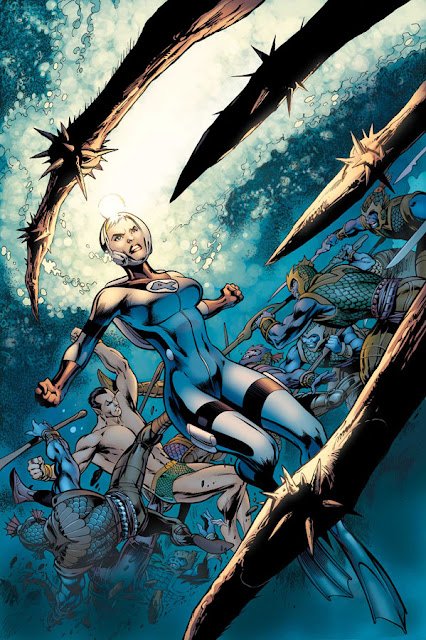 |
| Terrifically dynamic cover made this book a must have for me before I even knew my X-Men collection would go back this far. |
I'm not sure if I first came across Alan Davis' work in a collection of Alan Moore's DR and Quinch while rifling through whatever could be found in my local library or in back issue hunting for X-Men and coming across his X-Men Annuals. Nothing struck me too much about his work in either of those books though retrospectively they definitely have something I like. As you might expect I've gone back to his great Detective Comics run with Mike Barr and Captain Britain with Alan Moore but my affair with Davis beganwith a shockingly ugly shiny covered 90s number one.
 |
| I think odd costume design and odd characters helped make ClanDestine as short lived as it was. |
The book is extremely English and I think was never goning to take of. Issue three featured a cameo with Spider-Man which is where I was hooked on Davis' always charming and slick style added by the equally slick Mark Farmer, his now long-time art partner following the very competent Paul Neary who'd inked him for the first chunk of his career.
 |
| The splash that got me hooked. Nice! |
 | |
| Pile of bones becomes androgeanous old lady hair becomes trees, a la Neal Adams |
 | ||
| Davis draws tonnes of characters interestingly as well as Golden or Art Adams |
Davis came straight back to do a sequel with an uninspired title (Another Nail) but again showcasing great art. It allowed him to spotlight all DC's weird 60s and 70s characters like the Creeper and Black Orchid with as much gusto as he'd shown to Batman and Green Lantern in the first. Both solid books!
The Nail books set the precedent for what we would get from Davis going forward, a George Peréz style drive-through all his favourite bits of comics, drawing the characters he obviously has great affection for. Fantastic Four: The End, Killraven, Avenger:Prime, Uncanny X-Men, Superboy's Legion (with Farmer wrting) all have this "get everyone in" approach which works largely because he draws everyone so well.
Davis continues at Marvel today doing special projects and covers for the most part, the next being a Cap America run with Ed Brubaker which I hope will be full of Modoks and weird Kirby Nazis.
His ability to draw almost any character (always something odd about his Wolverine and Hulk for me...) combined with great composition and great Farmer's super slick inks and ink effects makes his covers always worth a look.
Davis' own website here including pencils which hightlight Farmer's contribution to the work.
As always a smattering of images pilferred via a Google search: "Alan Davis Comic"
 |
| Homage to Davis' own Excalibur #1 from ClanDestine Vol 2 |
 | ||
| God, I loved this cover. It would be years before I bought it just for the cover! (It's nice inside too!) |
 |
| Davis keeps pulling out the spectacular! |
 |
| Dynamic at a glance with horror upon closer inspection |


























